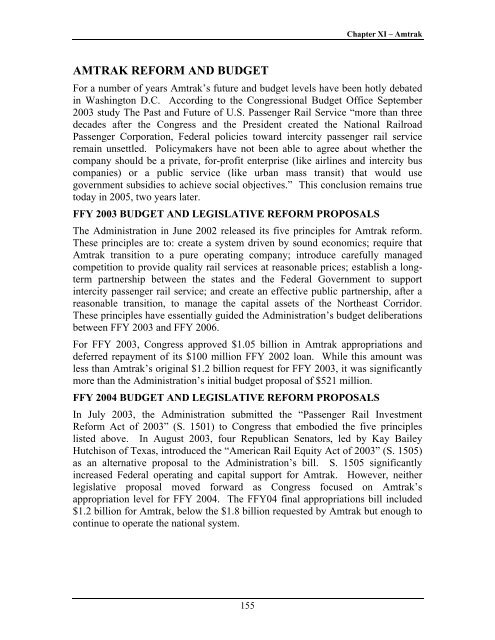California State Rail Plan 2005-06 to 2015-16
California State Rail Plan 2005-06 to 2015-16
California State Rail Plan 2005-06 to 2015-16
You also want an ePaper? Increase the reach of your titles
YUMPU automatically turns print PDFs into web optimized ePapers that Google loves.
Chapter XI – Amtrak<br />
AMTRAK REFORM AND BUDGET<br />
For a number of years Amtrak’s future and budget levels have been hotly debated<br />
in Washing<strong>to</strong>n D.C. According <strong>to</strong> the Congressional Budget Office September<br />
2003 study The Past and Future of U.S. Passenger <strong>Rail</strong> Service “more than three<br />
decades after the Congress and the President created the National <strong>Rail</strong>road<br />
Passenger Corporation, Federal policies <strong>to</strong>ward intercity passenger rail service<br />
remain unsettled. Policymakers have not been able <strong>to</strong> agree about whether the<br />
company should be a private, for-profit enterprise (like airlines and intercity bus<br />
companies) or a public service (like urban mass transit) that would use<br />
government subsidies <strong>to</strong> achieve social objectives.” This conclusion remains true<br />
<strong>to</strong>day in <strong>2005</strong>, two years later.<br />
FFY 2003 BUDGET AND LEGISLATIVE REFORM PROPOSALS<br />
The Administration in June 2002 released its five principles for Amtrak reform.<br />
These principles are <strong>to</strong>: create a system driven by sound economics; require that<br />
Amtrak transition <strong>to</strong> a pure operating company; introduce carefully managed<br />
competition <strong>to</strong> provide quality rail services at reasonable prices; establish a longterm<br />
partnership between the states and the Federal Government <strong>to</strong> support<br />
intercity passenger rail service; and create an effective public partnership, after a<br />
reasonable transition, <strong>to</strong> manage the capital assets of the Northeast Corridor.<br />
These principles have essentially guided the Administration’s budget deliberations<br />
between FFY 2003 and FFY 20<strong>06</strong>.<br />
For FFY 2003, Congress approved $1.05 billion in Amtrak appropriations and<br />
deferred repayment of its $100 million FFY 2002 loan. While this amount was<br />
less than Amtrak’s original $1.2 billion request for FFY 2003, it was significantly<br />
more than the Administration’s initial budget proposal of $521 million.<br />
FFY 2004 BUDGET AND LEGISLATIVE REFORM PROPOSALS<br />
In July 2003, the Administration submitted the “Passenger <strong>Rail</strong> Investment<br />
Reform Act of 2003” (S. 1501) <strong>to</strong> Congress that embodied the five principles<br />
listed above. In August 2003, four Republican Sena<strong>to</strong>rs, led by Kay Bailey<br />
Hutchison of Texas, introduced the “American <strong>Rail</strong> Equity Act of 2003” (S. 1505)<br />
as an alternative proposal <strong>to</strong> the Administration’s bill. S. 1505 significantly<br />
increased Federal operating and capital support for Amtrak. However, neither<br />
legislative proposal moved forward as Congress focused on Amtrak’s<br />
appropriation level for FFY 2004. The FFY04 final appropriations bill included<br />
$1.2 billion for Amtrak, below the $1.8 billion requested by Amtrak but enough <strong>to</strong><br />
continue <strong>to</strong> operate the national system.<br />
155













